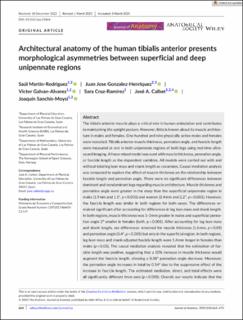| dc.description.abstract | The tibialis anterior muscle plays a critical role in human ambulation and contributes to maintaining the upright posture. However, little is known about its muscle architecture in males and females. One hundred and nine physically active males and females were recruited. Tibialis anterior muscle thickness, pennation angle, and fascicle length were measured at rest in both unipennate regions of both legs using real-time ultrasound imaging. A linear mixed model was used with muscle thickness, pennation angle, or fascicle length as the dependent variables. All models were carried out with and without total leg lean mass and shank length as covariates. Causal mediation analysis was computed to explore the effect of muscle thickness on the relationship between fascicle length and pennation angle. There were no significant differences between dominant and nondominant legs regarding muscle architecture. Muscle thickness and pennation angle were greater in the deep than the superficial unipennate region in males (1.9 mm and 1.1°, p < 0.001) and women (3.4 mm and 2.2°, p < 0.001). However, the fascicle length was similar in both regions for both sexes. The differences remained significant after accounting for differences in leg lean mass and shank length. In both regions, muscle thickness was 1–3 mm greater in males and superficial pennation angle 2° smaller in females (both, p < 0.001). After accounting for leg lean mass and shank length, sex differences remained for muscle thickness (1.6 mm, p < 0.05) and pennation angle (3.4°, p < 0.001) but only in the superficial region. In both regions, leg lean mass and shank-adjusted fascicle length were 1.4 mm longer in females than males (p < 0.05). The causal mediation analysis revealed that the estimation of fascicle length was positive, suggesting that a 10% increase in muscle thickness would augment the fascicle length, allowing a 0.38° pennation angle decrease. Moreover, the pennation angle increases in total by 0.54° due to the suppressive effect of the increase in fascicle length. The estimated mediation, direct, and total effects were all significantly different from zero (p < 0.001). Overall, our results indicate that the architectural anatomy of the tibialis anterior shows sexual dimorphism in humans. Tibialis anterior presents morphological asymmetries between superficial and deep unipennate regions in both sexes. Lastly, our causal mediation model identified a suppressive effect of fascicle length on the pennation angle, suggesting that increments in muscle thickness are not always aligned with increments in fascicle length or the pennation angle. | en_US |

